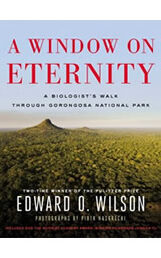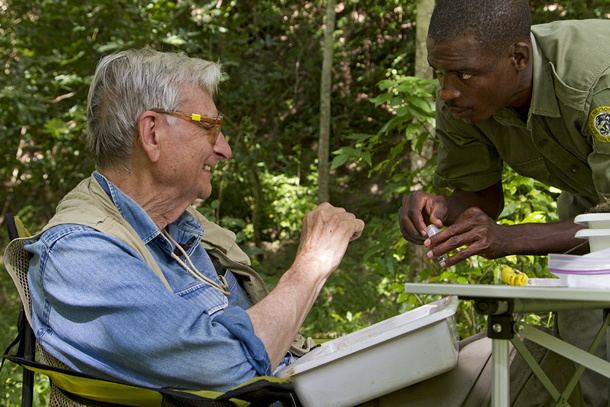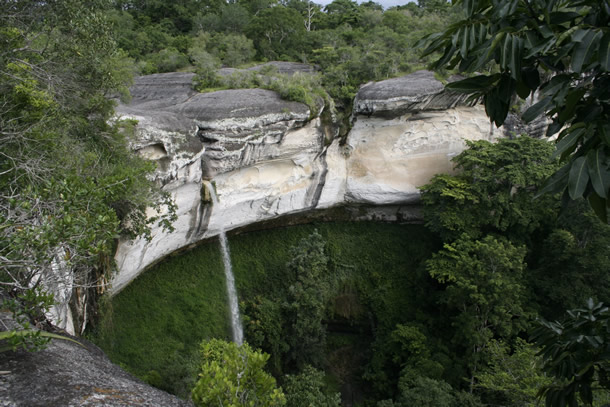

Edward O. Wilson is one of the most celebrated scientists in the United States, a world-renowned biologist and two-time Pulitzer Prize–winner. In his new book, A Window on Eternity: A Biologist’s Walk through Gorongosa National Park, Wilson shows why biodiversity is vital to the future of the Earth and to our own species through the story of Gorongosa National Park, which is located in Mozambique and is among the most diverse places on earth.
Last month Wilson returned to Gorongosa National Park for the formal opening of the Edward O. Wilson Biodiversity Laboratory. The E.O. Wilson Biodiversity Foundation will be communicating the work of scientists at the Laboratory through its partnership with the Gorongosa Restoration Project.
Gorongosa in Mwani tongue means “place of danger.” And it has been just that. After Mozambique won its independence from Portugal in 1975, a civil war broke out and raged for sixteen years. Because the park was close to the headquarters of one of the opposing armies, it became a battleground. Its tourist facilities were destroyed, and soldiers, hungry for any food they could forage, killed many of the large animals that once teemed in the park. The remarkable story in A Window on Eternity covers how Gorongosa was destroyed, restored, and continues to evolve back to its former state.


Edward O. Wilson examines ant species with a Gorongosa National Park guard. “We are glad that Mozambican scientists and international scientists will work side-by-side, learning from each other,” said Park Warden, Mr. Mateus Mutemba. Photograph by Piotr Naskrecki.
It is in places like Gorongosa Park in Africa, explains Wilson, that our own species evolved. Wilson takes readers to the forested groves of the park’s watershed on sacred Mount Gorongosa, then far away to deep gorges along the edge of the Rift Valley, places previously unexplored by biologists, with the aim of discovering new species and assessing their ancient origins. He treats readers to a war between termites and raider ants, describes “conversations” with elephant herds, and explains the importance of a one-day “bioblitz.”


Gorongosa National Park is home to some of the geologically diverse ecosystems on the African continent including, caves and deep gorges of the Cheringoma Plateau. Photograph by Piotr Naskrecki.
Bioblitzes are censuses of numbers of local species found and identified in a restricted area during a fixed period of time. Featured throughout the book are the creatures that he and his team have found—big and small alike—as illustrated in more than fifty stunning, full-color photographs by one of the world’s best wildlife photographers, Piotr Naskrecki. They range from large animals such as African elephants, lions, baboons, and warthogs; to birds, like yellow-billed storks and village weavers; to reptiles like the pygmy chameleon and Nile crocodile; to insects, including a variety of ants (Wilson’s specialty) and katydids; to spiders like the orb weaver and tarantulas.


Edward O. Wilson collecting insects—a passion that has lasted for over 60 years—in Gorongosa National Park. Photograph by Piotr Naskrecki.
As Wilson examines the near destruction and rebirth of Gorongosa, he analyzes the balance of nature, which, he observes, teeter’s on a razors edge. Loss of even a single species can have serious ramifications throughout an ecosystem, and yet we are carelessly destroying complex biodiverse ecosystems with unknown consequences. The wildlands in which these ecosystems flourish gave birth to humanity, and it is this natural world, still evolving, that may outlast us and become our legacy, our window on eternity.
Readers are introduced not only to remarkable animals but also to the people who are helping to restore the biodiversity in Gorgongosa. Gregory C. Carr, an American businessman and philanthropist, has adopted the park and its fauna and flora as his mission under the nonprofit Gregory C. Carr Foundation. Carr and Wilson, bound by a common devotion to wildlife conservation, have become collaborators and close friends in helping to extend conservation efforts. Because of Carr’s lobbying and advocacy, Gorongosa National Park has extended its boundaries and is creating schools and health clinics for local people, integrating human development with conservation, along with the newly dedicated Edward O. Wilson Biodiversity Laboratory. Here, in one of the remotest parts of Africa, the local people are beneficiaries of Africa’s greatest wildlife restoration story.
Conservationist Joyce Poole, one of the world’s leading authorities on the African elephant, has helped the traumatized elephants—who are scarred from the civil war—acclimate to humans. Her photographer-naturalist brother, Bob Poole, accompanied Wilson on his trips to Gorongosa, as did writer Morgan Ryan, who is co-author of E.O. Wilson’s Life on Earth, an iBook textbook, being prepared by the E.O. Wilson Biodiversity Foundation. Entomologist and photographer Piotr Naskrecki took most of the stunning photographs in the book. A DVD also accompanies the book and features Wilson’s wildlife guide, Tonga Torcida. It was made by Academy Award-winning director Jessica Yu.
Still, it is the lessons that Wilson invites readers to consider that are the heart of the book. Wilson explains how Homo sapiens’ evolution is inextricably tied to the continuing evolution of other species in wildlands. Since the origin of life on Earth billions of years ago, 99 percent of those species that ever existed have come to an end, replaced by others. From the fossil record, scientists have found that mammalian species (like our own) enjoy an average longevity of only about half a million years. Our unprecedented culture and rational power may vouchsafe humanity a much longer life span. Or, maybe not. Our unique powers could well shorten humanity’s time on earth. Today, Wilson laments, the wildlands of Earth are shrinking in acreage and in the human mind. Many writers call this new age the Anthropocene, wherein the planet is of, by, and for humanity. In the worldview of growing information and wealth, there is a restructuring of Earth to accommodate vast numbers of people. Wilson argues
“Please set aside the largest fraction of Earth’s surface possible as inviolate nature reserves. One-half would be nice. Conserving this land and sea is noble and a workable goal, especially when it includes those sections with the greatest density of species.”
How would natural parks, other reserves, and wildlife corridors that would connect them be preferable to a dozen more megacities? Wilson counts the ways, and leaves readers with the hopeful message that we can save global biodiversity, and advises that it would be wise for humanity “in the spirit of precautionary principle move as slowly and carefully as possible, if at all, into Earth’s surviving wild lands.”


Sable are one of 17 species of antelope in Gorongosa National Park. Thanks to the restoration effort, some large animal numbers have increased by as much as 40 percent. Photograph by Piotr Naskrecki.
Praised as “one of the finest scientists writing today” (Los Angeles Times), Wilson uses the story of Gorongosa to show the significance of biodiversity to humankind. And who wouldn’t want to walk through paradise with this most experienced and articulate guide?
A Window on Eternity: A Biologist’s Walk through Gorongosa National Park, published by by Simon & Shuster, is available for sale on April 22.
Read David Edmund Moody’s review of A Window on Eternity in the Huffington Post.
Read Jonathan Weiner’s review of A Window on Eternity in The New York Times.
The Most Biologically Diverse Place on Earth? from Simon and Schuster

